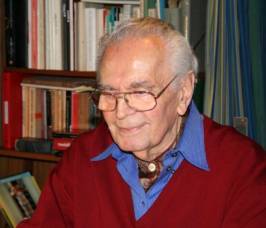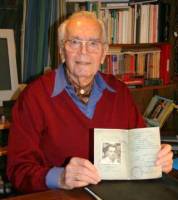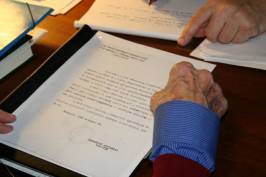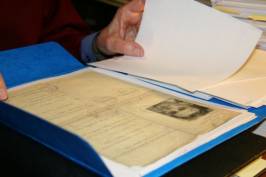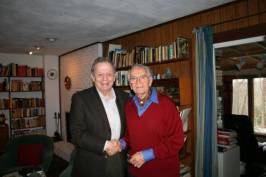A testimony of Dr. János Beér, a man who worked with Raoul Wallenberg
Dr. Mordecai Paldiel, Daniela Bajar, and Severo Reynoso, from the International Raoul Wallenberg Foundation, travelled to Cambridge, MA, to record Dr. Janos Beér’s testimony. Dr. Beér was part of the Schützling Protokoll, a department created by Raoul Wallenberg within the Swedish Legation with the objective of rescuing Schutzpass holders and accompanying them into safe houses. The role of the Schützling Protokoll was instrumental to the success of Raoul Wallenberg’s rescue operation in Budapest, 1944-45.
I was born on February 27, 1923, in Budapest as the only child to my parents Sándor and Gizella Beér. I was born Jewish. My father owned a workshop of business machines. I married my wife Marta Csato on October 27, 1944.The anti-Semitic laws of the prewar period did not particularly affect me. After matriculation, I entered the University of Technical and Economic Sciences in Budapest. In April 1944, I was conscripted into the army’s labor battalion. In August, the battalion was brought to Budapest and was prepared to be sent to Germany. I deserted from the battalion and joined a university squadron which had the secret objective of getting the country out of the war. When the Arrow Cross came to power in October 1944, they disbanded the squadron. Shortly afterwards, in the street, I ran into Tom Veres, a friend whom I knew from our common service in the labor battalion. He told me that he was working at the Swedish Legation as Raul Wallenberg’s photographer. He offered to introduce me to Wallenberg if I were interested in his work of rescuing Swedish protected Jews from the SS and the Arrow Cross. I agreed.
Wallenberg came to Budapest in July 1944 and has issued Swedish Protective Passports (Schutzpass) to Jews who had Swedish connections. The Schutzpass entailed the promise that the holder will be taken to Sweden as soon as the war activities would permit. In the meantime, Schutzpass holders may reside in special safe houses under the protection of the Swedish Legation in Budapest. This has worked until the Arrow Cross came to power in October 1944 and disregarded the agreement with the previous government. Many Schutzpass holders were taken prisoners in Arrow Cross party houses and were killed or prepared for deportation. Raul Wallenberg created a department within the Legation called Schützling Protokoll with the objective of rescuing Schutzpass holders and accompanying them into the safe houses. I was introduced to Wallenberg who accepted me in the Schützling Protokoll.
My first mission, on November 29, was to assist Wallenberg at the Józsefváros Freight Railway Station where men from Jewish labor battalions were put in cattle wagons to be deported. Many of them were known to the Schützling Protokoll to hold Schutzpasses. Wallenberg had permission from the German Embassy to take the holders of Swedish Schutzpasses out of the wagons. Tom Veres and I traveled with Wallenberg in his car to the Railway station. A small group from the legation was already there when we arrived. They had books with the detailed data of Schutzpass holders and a line was formed in front of a desk by people who either had their Schutzpasses with them or have claimed that it was taken from them. Their personal data had to be compared with the Legation’s record before they could be released into the custody of Wallenberg.
Tom Veres had taken photographs from the car with his disguised camera and my duty was to go to the wagons and talk to the people to make sure that everyone who had Swedish protection left the wagons and presented themselves to the examiners who also included Hungarian authorities. By the late afternoon more than one hundred men whose credentials were accepted were selected. Wallenberg arranged for them to be escorted by police to one of the safe Swedish protected houses.
When we got back into his car it occurred to him that the people he rescued have not eaten all day and, instead of calling it a day and going back to the Legation, he asked his driver to head for the safe house to make sure that the group of men will be met by food, a warm soup when they arrive. I should mention that Wallenberg had not eaten either all day; we brought sandwiches but Tom Veres inadvertently sat on Walleberg’s sandwich in the car, but Wallenberg could only be concerned about the people he just rescued. A small event that, for me however, underlined this great man’s humanity.
The next day, we returned to the train station, but this time we were not successful. The SS man in charge accused Wallenberg of having gotten the men under false pretences the previous day and threatened to shoot us if we did not leave immediately. Wallenberg signaled to us and the driver to leave.
In the Schützling Protokoll my colleague was András Szentgyörgyi, a young journalist imaginative and brave, much inspired by Wallenberg. One day, we went to a party house of the Arrow Cross and said we wanted to speak to the man in charge. The headman there asked us why Sweden was so much interested in Jews and not, for example, helping the Veteran’s Hospital in Budapest. He hinted that he wanted some donation to the Hospital for releasing the three Jews on our list. We promised to report this request to the Legation and the persons were freed; we then took them directly to the International Ghetto. I reported this to Wallenberg. He told us that the next time we should give the Arrow Cross a check already signed by him, and fill in the amount needed. I think it was either 500 or 1,000 pengös. There, indeed, was a next time. The Arrow Cross people contacted us that they had people with Swedish papers, and to come and get them, and not to forget to bring along the check for the Veteran’s Hospital.
I was very much impressed by Wallenberg. Tom Veres called him Pimpernel, like the Scarlet Pimpernel in the movie. In fact, he looked similar to the British actor Leslie Howard, who played the Pimpernel role in a pre-war film. Wallenberg was very brave, but not reckless. He knew and appreciated the dangers. There was much solidarity in our group, and we knew we could rely on Wallenberg in case of trouble.
Wallenberg got me a certificate from the Commissioner of the Jewish Ghetto to permit entering and leaving the ghetto within certain hours of the day, as a liaison of the Swedish Legation. During December, I made about five forays in the ghetto to take about 70 people who showed evidence to the authorities of being Schutzpass holders, from the Jewish ghetto to Swedish protected houses. The distance they had to walk from the ghetto was about a couple of miles and they were accompanied by police men for their protection. The Swedish contingent in the International Ghetto numbered approximately 7-10,000 people.
I slept in the Legation building. My wife stayed with friends elsewhere until the end of the year and then moved also to the Legation. As for my parents, they were staying with friends on the outskirts of the city. I continued working with the Schutzling-Protokoll until the arrival of the Russians. On one occasion, when the Russian front moved into the city, a Wehrmacht unit came into the Legation building with machine guns to take up a position. They left after being told that this was diplomatic territory.
In November 1956, my wife and I fled Hungary after Russian tanks crushed the 1956 Hungarian revolution, and eventually settled in the United States. I am a Professor Emeritus of Chemical and Fuel Engineering at the Massachusetts Institute of Technology (MIT), in Cambridge, Massachusetts.
On the recommendation of the late Tom Lantos, member of the U.S. Congress, my wife and I have left our documents relating to our connection with Wallenberg, including the mentioned certificate issued by the Commissioner of the Ghetto, to the U.S. Holocaust Museum in Washington, DC.
Credits:
Recorded by Dr. Mordecai Paldiel, Daniela Bajar and Severo Reynoso & slightly revised per Prof. Beér’s annotations
January 31, 2010

